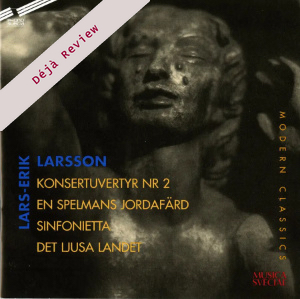
Déjà Review: this review was first published in September 2003 and the recording is still available.
Lars-Erik Larsson (1908-1986)
Concert Overture No 2, Op 13 (1934)
A Fiddler’s Last Journey, Ballad for baritone and orchestra, Op 1 (1927)
Sinfonietta for String Orchestra, Op 10 (1932)
The Bright Country – Cantata for soloists, chorus and orchestra, Op 11 (1932)
Karl-Magnus Fredriksson (baritone), Lena Hoel (soprano)
Swedish Radio Choir
Sami Sinfonietta/Stefan Parkman
rec. 2000, Studio 2, Radiohuset, Stockholm, Sweden
Phono Suecia PSCD714 [63]
Larsson’s position as composer-in-residence to Swedish Radio assured his music of encouragement and exposure. This was a position he held from 1937 to 1953. These works, written between the ages of 19 and 26, predate that appointment. His Pastoral Suite (deftly poetic and light on the aural palate) and the phenomenally successful God in Disguise (recently recorded with English language narration by Intim Musik) were works well lodged in the Swedish consciousness. Their impact was extended across the world through transcription discs freely distributed to radio stations.
There are three concert overtures. The Second Concert Overture is busy, neo-classical, pesante and heartless. You could not say that of his 1927 Fiddler’s Last Journey. This is a ballad for baritone and orchestra. It is his Op. 1. This is a romantic piece which would with some adjustment have suited Jussi Björling. It has a slow cortège tread and a patriotic nobility which is strange in a piece setting a poem about the funeral of a country fiddler. Nature pays more heed to his passing than the country folk he had entertained. The music is strongly reminiscent of the orchestral songs of Grieg, Sibelius and Alfvén.
Slip forward five years for the Sinfonietta and look in vain for any shred of Nordic romanticism. This is purposeful and neo-classical and bustles along rather than sings – like a blend of Holst, Rawsthorne and Hindemith. A cool humanity rises gently from the placid extended Largo with a central Presto section. After a première by Tor Mann the piece made a favourable impact at the 1934 ISCM in Florence but the composer later withdrew the piece.
The Bright Country is from the same year as the Sinfonietta, a work drastically different in style. This cantata for soloists, chorus and orchestra was written for a competition run by the Swedish Federation of Choirs. The poems are by Joel Rundt. They extol the beauties of the Ostrobothnian countryside. In this piece we trace the pastoral idyllica discerned from other Larsson cantatas including The God in Disguise, The Hours of the Day and The Red Cross. This is not demanding music being smilingly singable and with no disorientating trendy-arty voices. It has much the same artless lack of affectation as his Op. 1. The choir and orchestra evoke patriotic sentiments in music that maintains a soft and complacent curve. This makes for undemanding and pleasing listening without stirring the mind or emotions unduly.
The disc neatly couples two works from Larsson’s early pastoral style and two others from his co-existing neo-classical face.
For Scandinavian music enthusiasts and choral societies interested in trying an example of smooth Nordic romanticism.
Rob Barnett
Buying this recording via a link below generates revenue for MWI, which helps the site remain free



















